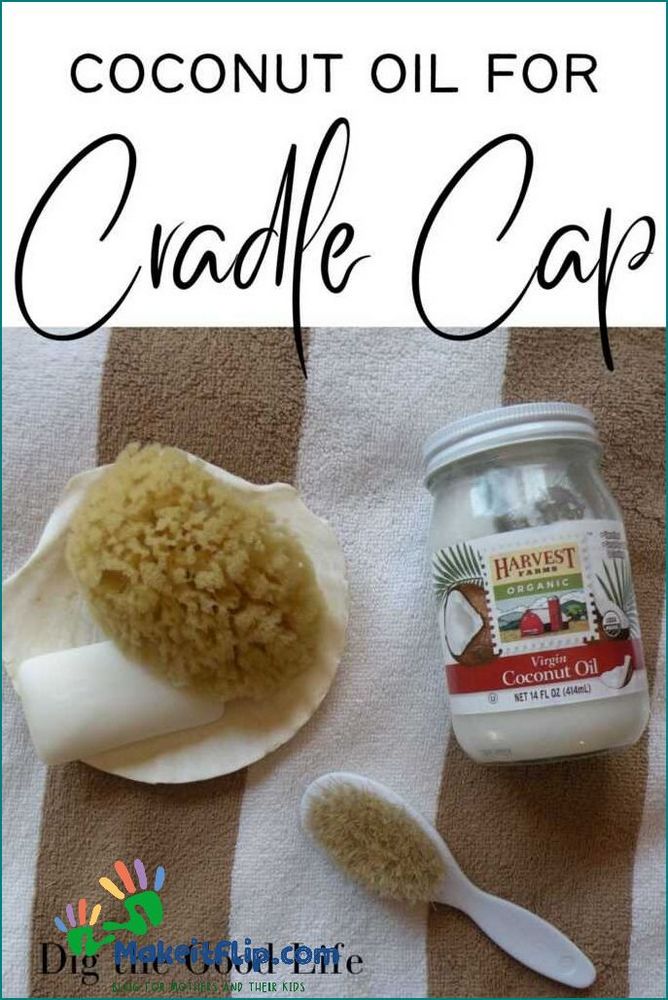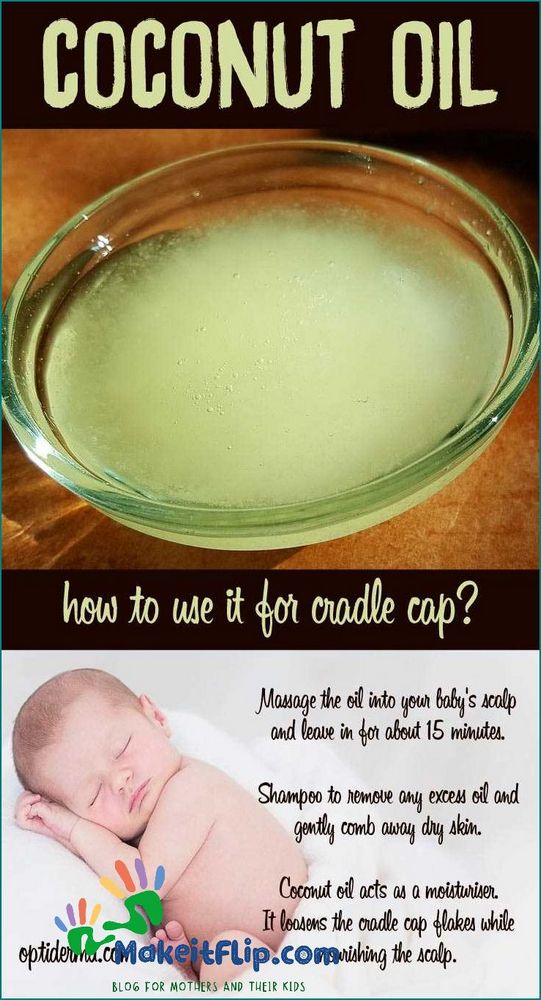Contents
- 1 Using Coconut Oil as a Natural Remedy for Cradle Cap: A Step-by-Step Guide
- 1.1 Understanding Cradle Cap
- 1.2 Using Coconut Oil for Cradle Cap
- 1.3 FAQ about topic How to Use Coconut Oil for Cradle Cap A Natural Remedy
- 1.3.1 What is cradle cap?
- 1.3.2 How can coconut oil help with cradle cap?
- 1.3.3 How do I use coconut oil for cradle cap?
- 1.3.4 Are there any risks or side effects of using coconut oil for cradle cap?
- 1.3.5 Can I use coconut oil for cradle cap on a daily basis?
- 1.3.6 What is cradle cap?
- 1.3.7 How can coconut oil help with cradle cap?
- 1.3.8 How do I use coconut oil for cradle cap?
- 1.3.9 Are there any risks or side effects of using coconut oil for cradle cap?
Using Coconut Oil as a Natural Remedy for Cradle Cap: A Step-by-Step Guide

Cradle cap, also known as seborrheic dermatitis, is a common condition that affects many infants. It is characterized by scaly, crusty patches on the scalp, and can be accompanied by redness and irritation. While cradle cap is not harmful or contagious, it can be unsightly and cause discomfort for your little one. Fortunately, there are natural remedies that can help alleviate the symptoms, and one such remedy is coconut oil.
Coconut oil has been used for centuries for its various health benefits, and it can also be effective in treating cradle cap. This natural oil is rich in lauric acid, which has antimicrobial and anti-inflammatory properties. These properties can help soothe the irritated skin and reduce the inflammation associated with cradle cap.
To use coconut oil for cradle cap, simply apply a small amount of the oil directly to your baby’s scalp. Gently massage it in using circular motions, making sure to cover the affected areas. Leave the oil on for about 15 minutes to allow it to penetrate the skin. Then, using a soft brush or comb, gently brush away the loosened flakes. Finally, wash your baby’s hair with a mild baby shampoo to remove any remaining oil.
It is important to note that coconut oil may not work for everyone, and some babies may be allergic to it. If you notice any adverse reactions or if the cradle cap persists or worsens, it is best to consult with your pediatrician for further guidance. However, for many parents, coconut oil has proven to be a safe and effective natural remedy for cradle cap.
Understanding Cradle Cap

Cradle cap is a common condition that affects many infants. It is characterized by the presence of yellowish, greasy scales or flakes on the scalp. The exact cause of cradle cap is unknown, but it is believed to be related to overactive oil glands in the baby’s skin.
Coconut oil is a natural remedy that can be used to treat cradle cap. It has antimicrobial properties that can help reduce the growth of yeast on the scalp, which is thought to contribute to the development of cradle cap. Additionally, coconut oil can moisturize the scalp and help loosen the scales, making them easier to remove.
When using coconut oil for cradle cap, it is important to apply it gently to the affected area. Massage a small amount of coconut oil onto the scalp, being careful not to rub too hard or scratch the skin. Leave the oil on for a few minutes to allow it to penetrate the scalp, then gently comb through the hair to remove any loose scales.
It is recommended to repeat this process daily until the cradle cap improves. In some cases, it may take several weeks for the condition to completely resolve. If the cradle cap persists or worsens, it is best to consult a healthcare professional for further evaluation and treatment options.
In conclusion, understanding cradle cap and how to use coconut oil as a natural remedy can help parents effectively manage this common condition in infants. By gently applying coconut oil to the affected area and regularly removing loose scales, parents can help alleviate the symptoms of cradle cap and promote a healthy scalp for their baby.
What is Cradle Cap?

Cradle cap is a common skin condition that affects infants. It is characterized by yellow, crusty patches on the scalp. The condition is not harmful or contagious, but it can be unsightly and cause discomfort for the baby.
Although the exact cause of cradle cap is unknown, it is believed to be related to overactive sebaceous glands in the baby’s skin. These glands produce an oily substance called sebum, which can build up and form crusty patches on the scalp.
Coconut oil is a natural remedy that can be used to treat cradle cap. It has antimicrobial properties that can help reduce the growth of bacteria or fungi on the scalp. Additionally, coconut oil is moisturizing and can help soften and loosen the crusty patches, making them easier to remove.
Using coconut oil for cradle cap is simple. Gently massage a small amount of coconut oil onto the affected areas of the baby’s scalp. Leave it on for a few minutes to allow it to penetrate the skin, then gently brush the scalp with a soft brush or comb to remove the loosened crusts. Repeat this process daily until the cradle cap clears up.
It is important to note that cradle cap usually resolves on its own within a few months, even without treatment. However, using coconut oil can help speed up the healing process and provide relief for the baby.
Causes of Cradle Cap

Cradle cap is a common skin condition that affects infants, typically appearing within the first few months of life. It is characterized by thick, yellowish or brownish scales on the scalp, which can sometimes spread to other areas of the body.
The exact cause of cradle cap is unknown, but there are several factors that may contribute to its development. One possible cause is an overproduction of oil (sebum) in the sebaceous glands of the scalp. This excess oil can lead to the formation of scales and flakes.
Another possible cause is a fungal infection. The fungus Malassezia is commonly found on the skin and scalp, but in some cases, it can grow out of control and cause cradle cap. This can be triggered by hormonal changes in the baby’s body or an imbalance in the skin’s natural microbiome.
Other factors that may contribute to the development of cradle cap include a family history of the condition, certain medications, and a weakened immune system. It is also more common in babies who have dry skin or eczema.
While cradle cap is not harmful or contagious, it can cause discomfort and itchiness for the baby. It is important to treat cradle cap gently and avoid picking or scratching at the scales, as this can lead to secondary infections.
Using coconut oil as a natural remedy for cradle cap can help moisturize the scalp and loosen the scales, making them easier to remove. The antimicrobial properties of coconut oil may also help to reduce the growth of the fungus that causes cradle cap.
It is important to note that while coconut oil can be effective in treating cradle cap, it may not work for all babies. If the condition persists or worsens, it is recommended to consult a pediatrician for further evaluation and treatment options.
Symptoms of Cradle Cap

Cradle cap is a common skin condition that affects infants, typically within the first few months of life. It is characterized by the presence of yellow or white scales on the scalp, which can sometimes extend to the eyebrows, ears, and other parts of the face.
The main symptoms of cradle cap include:
| 1. Scalp flakes: | The most noticeable symptom of cradle cap is the presence of thick, greasy flakes on the baby’s scalp. These flakes can be yellow or white in color and may appear crusty or scaly. |
| 2. Redness and inflammation: | In some cases, cradle cap can cause redness and inflammation on the affected areas of the scalp. This can be accompanied by itchiness and discomfort for the baby. |
| 3. Hair loss: | Severe cases of cradle cap may lead to hair loss in the affected areas. This is usually temporary and the hair will grow back once the condition is treated. |
| 4. Irritability: | Babies with cradle cap may become irritable and fussy due to the discomfort caused by the condition. They may also experience difficulty sleeping. |
| 5. Odor: | In some cases, cradle cap can produce a mild odor. This is usually caused by the buildup of oils and dead skin cells on the scalp. |
If you notice any of these symptoms on your baby’s scalp, it is important to consult a healthcare professional for a proper diagnosis and treatment plan. Using coconut oil for cradle cap is a natural remedy that can help moisturize the scalp and loosen the scales, making them easier to remove.
Using Coconut Oil for Cradle Cap

Cradle cap is a common condition that affects many infants. It is characterized by crusty, yellow or brown scales on the scalp. While it is not harmful or painful, it can be unsightly and cause discomfort for your baby. Fortunately, coconut oil can be an effective natural remedy for cradle cap.
Coconut oil is known for its moisturizing and antimicrobial properties, which can help to soften the scales and reduce inflammation. To use coconut oil for cradle cap, follow these steps:
| Step 1 | Warm a small amount of coconut oil in your hands until it becomes liquid. |
| Step 2 | Gently massage the oil onto your baby’s scalp, focusing on the areas affected by cradle cap. |
| Step 3 | Leave the coconut oil on your baby’s scalp for about 15 minutes to allow it to penetrate the scales. |
| Step 4 | Using a soft brush or comb, gently remove the scales from your baby’s scalp. |
| Step 5 | Wash your baby’s scalp with a gentle baby shampoo to remove any remaining coconut oil. |
It is important to note that cradle cap may require multiple treatments with coconut oil before the scales completely disappear. Additionally, some infants may be allergic to coconut oil, so it is recommended to perform a patch test before using it on your baby’s scalp.
In conclusion, coconut oil can be a safe and natural remedy for cradle cap. Its moisturizing and antimicrobial properties can help to soften the scales and reduce inflammation. By following the steps outlined above, you can effectively use coconut oil to treat your baby’s cradle cap.
Benefits of Coconut Oil for Cradle Cap

Coconut oil is a natural remedy that can be used to treat cradle cap, a common condition in infants. Here are some of the benefits of using coconut oil for cradle cap:
- Moisturizes the scalp: Coconut oil helps to moisturize the scalp, reducing dryness and flakiness associated with cradle cap.
- Antifungal properties: Coconut oil contains lauric acid, which has antifungal properties that can help to combat the yeast overgrowth that contributes to cradle cap.
- Gentle and safe: Coconut oil is a gentle and safe option for treating cradle cap in infants, as it is free from harsh chemicals and additives.
- Reduces inflammation: The anti-inflammatory properties of coconut oil can help to reduce redness and irritation on the scalp caused by cradle cap.
- Nourishes the skin: Coconut oil is rich in vitamins and nutrients that can nourish and soothe the skin, promoting healing and preventing further irritation.
- Easily absorbed: Coconut oil is easily absorbed into the skin, allowing it to penetrate deeply and provide maximum benefits for treating cradle cap.
Overall, coconut oil is a natural and effective remedy for cradle cap, providing numerous benefits for both the scalp and skin of infants. It is important to choose a high-quality, organic coconut oil for the best results.
FAQ about topic How to Use Coconut Oil for Cradle Cap A Natural Remedy
What is cradle cap?
Cradle cap is a common skin condition that affects infants. It is characterized by yellowish, greasy patches on the scalp.
How can coconut oil help with cradle cap?
Coconut oil can help with cradle cap because it has antimicrobial and anti-inflammatory properties. It can moisturize the scalp and help loosen the scales.
How do I use coconut oil for cradle cap?
To use coconut oil for cradle cap, you can apply a small amount of oil directly to the affected area. Gently massage it into the scalp and let it sit for a few minutes. Then, use a soft brush or cloth to gently remove the scales. Finally, rinse the scalp with warm water and gently pat dry.
Are there any risks or side effects of using coconut oil for cradle cap?
Coconut oil is generally safe to use for cradle cap. However, if your baby has a known allergy to coconuts, it is best to avoid using coconut oil. Additionally, if the cradle cap worsens or does not improve after using coconut oil, it is recommended to consult a healthcare professional.
Can I use coconut oil for cradle cap on a daily basis?
Yes, you can use coconut oil for cradle cap on a daily basis. However, it is important to monitor your baby’s skin for any signs of irritation or allergic reaction. If any adverse reactions occur, discontinue use and consult a healthcare professional.
What is cradle cap?
Cradle cap is a common skin condition that affects infants. It is characterized by scaly, crusty patches on the scalp.
How can coconut oil help with cradle cap?
Coconut oil can help with cradle cap because it has moisturizing and antimicrobial properties. It can help soften the scales and reduce inflammation on the scalp.
How do I use coconut oil for cradle cap?
To use coconut oil for cradle cap, gently massage a small amount of oil onto your baby’s scalp. Let it sit for a few minutes, then use a soft brush or cloth to gently remove the scales. Repeat this process daily until the cradle cap improves.
Are there any risks or side effects of using coconut oil for cradle cap?
Coconut oil is generally safe to use for cradle cap, but some babies may be allergic to it. It’s always a good idea to do a patch test on a small area of your baby’s skin before using coconut oil on the scalp. If any irritation or allergic reaction occurs, discontinue use and consult a doctor.
I’m Diana Ricciardi, the author behind Makeitflip.com. My blog is a dedicated space for mothers and their kids, where I share valuable insights, tips, and information to make parenting a bit easier and more enjoyable.
From finding the best booster seat high chair for your child, understanding the connection between sciatica and hip pain, to exploring the benefits of pooping in relieving acid reflux, I cover a range of topics that are essential for every parent.
My goal is to provide you with practical advice and solutions that you can easily incorporate into your daily life, ensuring that you and your child have the best possible experience during these precious years.
